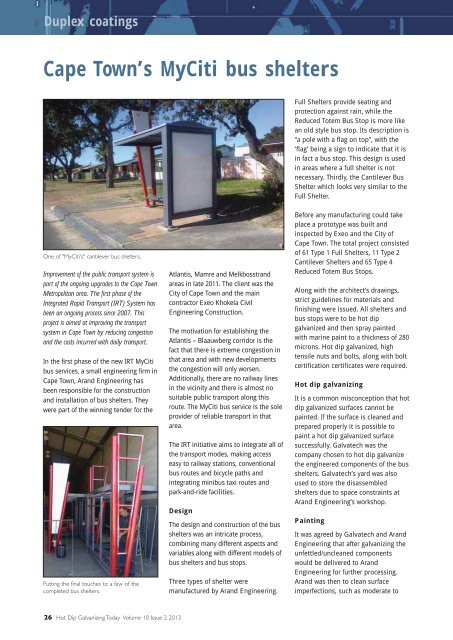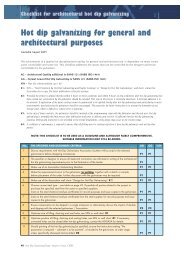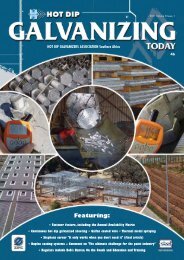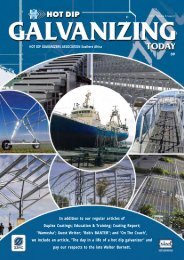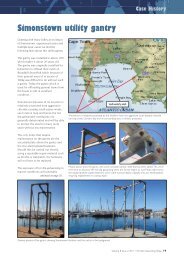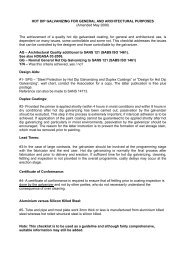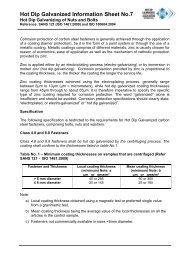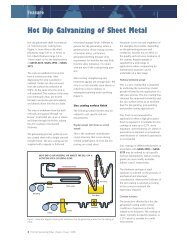Fasteners - hdgasa
Fasteners - hdgasa
Fasteners - hdgasa
You also want an ePaper? Increase the reach of your titles
YUMPU automatically turns print PDFs into web optimized ePapers that Google loves.
Duplex coatings<br />
Cape Town’s MyCiti bus shelters<br />
Full Shelters provide seating and<br />
protection against rain, while the<br />
Reduced Totem Bus Stop is more like<br />
an old style bus stop. Its description is<br />
“a pole with a flag on top”, with the<br />
‘flag’ being a sign to indicate that it is<br />
in fact a bus stop. This design is used<br />
in areas where a full shelter is not<br />
necessary. Thirdly, the Cantilever Bus<br />
Shelter which looks very similar to the<br />
Full Shelter.<br />
One of "MyCiti's" cantilever bus shelters.<br />
Improvement of the public transport system is<br />
part of the ongoing upgrades to the Cape Town<br />
Metropolitan area. The first phase of the<br />
Integrated Rapid Transport (IRT) System has<br />
been an ongoing process since 2007. This<br />
project is aimed at improving the transport<br />
system in Cape Town by reducing congestion<br />
and the costs incurred with daily transport.<br />
In the first phase of the new IRT MyCiti<br />
bus services, a small engineering firm in<br />
Cape Town, Arand Engineering has<br />
been responsible for the construction<br />
and installation of bus shelters. They<br />
were part of the winning tender for the<br />
Putting the final touches to a few of the<br />
completed bus shelters.<br />
Atlantis, Mamre and Melkbosstrand<br />
areas in late 2011. The client was the<br />
City of Cape Town and the main<br />
contractor Exeo Khokela Civil<br />
Engineering Construction.<br />
The motivation for establishing the<br />
Atlantis – Blaauwberg corridor is the<br />
fact that there is extreme congestion in<br />
that area and with new developments<br />
the congestion will only worsen.<br />
Additionally, there are no railway lines<br />
in the vicinity and there is almost no<br />
suitable public transport along this<br />
route. The MyCiti bus service is the sole<br />
provider of reliable transport in that<br />
area.<br />
The IRT initiative aims to integrate all of<br />
the transport modes, making access<br />
easy to railway stations, conventional<br />
bus routes and bicycle paths and<br />
integrating minibus taxi routes and<br />
park-and-ride facilities.<br />
Design<br />
The design and construction of the bus<br />
shelters was an intricate process,<br />
combining many different aspects and<br />
variables along with different models of<br />
bus shelters and bus stops.<br />
Three types of shelter were<br />
manufactured by Arand Engineering.<br />
Before any manufacturing could take<br />
place a prototype was built and<br />
inspected by Exeo and the City of<br />
Cape Town. The total project consisted<br />
of 61 Type 1 Full Shelters, 11 Type 2<br />
Cantilever Shelters and 65 Type 4<br />
Reduced Totem Bus Stops.<br />
Along with the architect’s drawings,<br />
strict guidelines for materials and<br />
finishing were issued. All shelters and<br />
bus stops were to be hot dip<br />
galvanized and then spray painted<br />
with marine paint to a thickness of 280<br />
microns. Hot dip galvanized, high<br />
tensile nuts and bolts, along with bolt<br />
certification certificates were required.<br />
Hot dip galvanizing<br />
It is a common misconception that hot<br />
dip galvanized surfaces cannot be<br />
painted. If the surface is cleaned and<br />
prepared properly it is possible to<br />
paint a hot dip galvanized surface<br />
successfully. Galvatech was the<br />
company chosen to hot dip galvanize<br />
the engineered components of the bus<br />
shelters. Galvatech’s yard was also<br />
used to store the disassembled<br />
shelters due to space constraints at<br />
Arand Engineering’s workshop.<br />
Painting<br />
It was agreed by Galvatech and Arand<br />
Engineering that after galvanizing the<br />
unfettled/uncleaned components<br />
would be delivered to Arand<br />
Engineering for further processing.<br />
Arand was then to clean surface<br />
imperfections, such as moderate to<br />
26 Hot Dip Galvanizing Today Volume 10 Issue 2 2013


